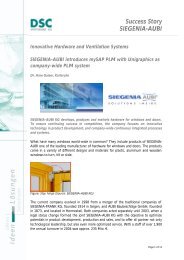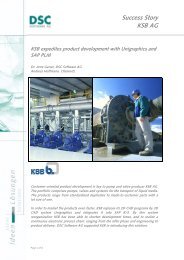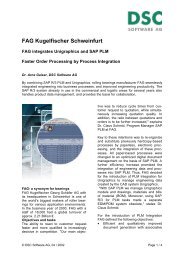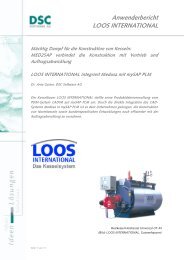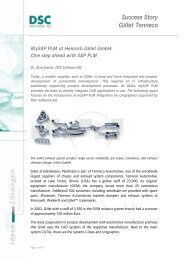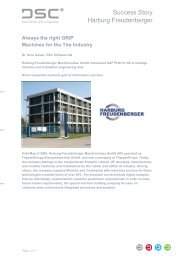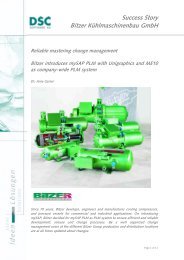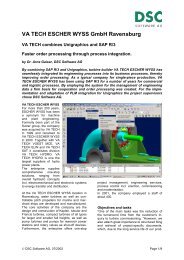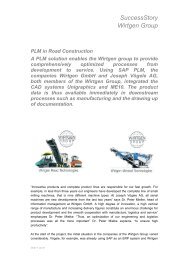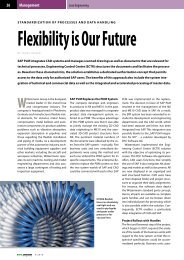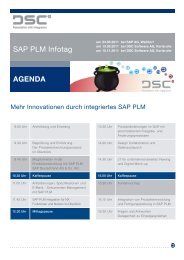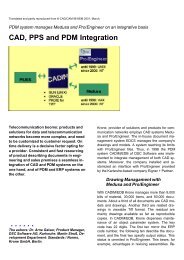Success Story Neuson Kramer - DSC Software AG
Success Story Neuson Kramer - DSC Software AG
Success Story Neuson Kramer - DSC Software AG
You also want an ePaper? Increase the reach of your titles
YUMPU automatically turns print PDFs into web optimized ePapers that Google loves.
Page 1 of 10<br />
<strong>Success</strong> <strong>Story</strong><br />
<strong>Neuson</strong> <strong>Kramer</strong> Baumaschinen <strong>AG</strong><br />
<strong>Neuson</strong> <strong>Kramer</strong> Group banks on SAP PLM and NX<br />
Modern Design, innovation, quality, and fast processes<br />
Standardization of systems and processes<br />
Dr. Arne Gaiser, <strong>DSC</strong> <strong>Software</strong> <strong>AG</strong><br />
The international operating company group <strong>Neuson</strong> <strong>Kramer</strong> Baumaschinen <strong>AG</strong> is a<br />
leading European full range supplier of compact construction machinery. The leading<br />
market position in Europe bases on technological innovative products enabling the<br />
company to react to customer request and market changes - fast and "compact". For<br />
this, the company focuses on a SAP-based infrastructure, and company-wide consistent<br />
processes.<br />
Fig. 1: The product range of <strong>Neuson</strong> <strong>Kramer</strong> Baumaschinen <strong>AG</strong><br />
<strong>Neuson</strong> <strong>Kramer</strong> Baumaschinen <strong>AG</strong><br />
In 2001, <strong>Neuson</strong> <strong>Kramer</strong> Baumaschinen <strong>AG</strong> emerged from <strong>Neuson</strong> Hydraulik GmbH, founded<br />
1981 in Linz, Austria. Today, shareholdings and acquisitions enables the group to offer a<br />
comprehensive range of compact construction machinery including customized financing:<br />
Mini and compact excavators (<strong>Neuson</strong> Baumaschinen GmbH)<br />
Wheel loaders and telescopic loaders (<strong>Kramer</strong> Werke GmbH)<br />
Dumpers (Lifton Dumpers Ltd.)<br />
Forestry machines "Harvester" (MHT - MechHydTronic GmbH)<br />
Trading & rental of construction machinery (Stambach Baumaschinen GmbH)<br />
Financing and leasing (NK Finance Immorent GmbH)
Page 2 of 10<br />
<strong>Success</strong> <strong>Story</strong><br />
<strong>Neuson</strong> <strong>Kramer</strong> Baumaschinen <strong>AG</strong><br />
Heterogeneous systems and processes<br />
In 2000, the <strong>Neuson</strong> group was strategically re-oriented. At this time, about 10 companies<br />
belonged to the holding with separate systems for CAD, drawing management, and ERP.<br />
Moreover, the company portfolio comprised not only make-to-order construction but also serial<br />
production. Thus, one of the main tasks was to standardize systems and processes to realize<br />
synergies, and simultaneous engineering.<br />
Synergies by standardization of software, hardware,<br />
and processes<br />
In order to realize synergies for the subsidiaries and within the overall new company strategy,<br />
systems had to be standardized and harmonized. In 2000, the top management decided to<br />
subsidiary-wide introduces NX as the strategic CAD system, and SAP as commercial and<br />
logistic system. To fully benefit from the system standardization, processes were also to be<br />
standardized. This easily integrates new locations and companies into the overall strategy.<br />
Fig. 2: SAP and NX represent strategic systems at <strong>Neuson</strong> <strong>Kramer</strong> Baumaschinen <strong>AG</strong><br />
Objectives of PLM<br />
The selection of a company-wide PLM system was also subject to the strategic target of system<br />
standardizing and process harmonization. After intensive work benching of several PLM<br />
systems, at the end of 2003, <strong>Neuson</strong> <strong>Kramer</strong> decided for SAP PLM for managing and filing all<br />
technical documents. With SAP PLM a common platform for simultaneous engineering was to<br />
be created. For that, the SAP system with its infrastructural design for distributed locations<br />
offered ideal prerequisites. For the company-wide use, a standard number assignment system<br />
and a location-spanning classification were to be introduced. Even more attention, the top<br />
management turned to standardization and compatibility of processes.
Page 3 of 10<br />
<strong>Success</strong> <strong>Story</strong><br />
<strong>Neuson</strong> <strong>Kramer</strong> Baumaschinen <strong>AG</strong><br />
And here, especially to the introduction of a standardized authorization concept, defined<br />
release and revision processes. In order to increase the standardization of products, the<br />
reduction of the part range, and achieving a higher re-use rate were additional requirements.<br />
Process harmonization was expected to have the biggest effects. With PLM a company-wide<br />
standardized and integrated product development was to be introduced: from the prototyping<br />
sample to the serial production part. The engineering process was to be successively<br />
integrated into other processes, such as purchase, sales and CRM (suppliers and partner).<br />
Fig. 3: The PLM project went productive within 9 months<br />
Milestones of the PLM project<br />
At the end of 2003, the executive board of <strong>Neuson</strong> <strong>Kramer</strong> <strong>AG</strong> approved the PLM project. For<br />
the realization a project team was established consisting of members from the consultant<br />
company Matrics, plant construction company FMW, construction machinery manufacturer<br />
<strong>Kramer</strong> and <strong>Neuson</strong>, and PLM consultant company <strong>DSC</strong> <strong>Software</strong> <strong>AG</strong>. In the beginning of<br />
2004, the hardware for the SAP Content Server was purchased and set up. Mid-February of<br />
2004, test installations were set up at three locations. They served to build up know-how in the<br />
project team, and to check several process options. At the same time, a basic concept was<br />
prepared which formed the basis for the implementation of standard functions and processes.<br />
Beginning June of 2004, the detailed specification was approved, and realized until July of<br />
2004. At the end of July 2004, <strong>Neuson</strong> <strong>Kramer</strong> approved the integration solution, and the user<br />
were trained. In August of 2004, the solution went productive at <strong>Neuson</strong>, FMW and <strong>Kramer</strong>.<br />
Since January of 2005, also legacy data of the previous management system IMAN is available<br />
in SAP PLM.
Fig. 4a: Example of a 2D drawing of an arm for an excavator<br />
Fig. 4b: Excavator arm (welding assembly)<br />
Standardized processes and<br />
company-wide cooperation<br />
Page 4 of 10<br />
<strong>Success</strong> <strong>Story</strong><br />
<strong>Neuson</strong> <strong>Kramer</strong> Baumaschinen <strong>AG</strong><br />
"The most important objective of our PLM project - analogous processes both, at serial<br />
manufacturer <strong>Neuson</strong>-<strong>Kramer</strong> and make-to-order manufacturer FMW - we have achieved,"<br />
stresses Anton Müchler, Head of Group IT. Basic premises here were, among other things, a<br />
standardized filing of all documents in the SAP filing system, and a company-wide access. For<br />
the management of technical documents four document types were introduced: NXM for NX<br />
models, NXD for NX drawings, NXF for part family templates, and TED for the rest of technical<br />
documents, such as, check reports, data sheets, diagrams and assembly instructions. With the<br />
exception of part families, the number assignment was set to internal. The meta data is<br />
centrally managed, and the originals managed in a SAP Content Server at the using location.
Standardized processes<br />
Page 5 of 10<br />
<strong>Success</strong> <strong>Story</strong><br />
<strong>Neuson</strong> <strong>Kramer</strong> Baumaschinen <strong>AG</strong><br />
Models and drawings in the group today are product-independent subject to a standardized<br />
release strategy, both in serial production and single machines. "A completed drawing - status<br />
AO - is forwarded to checkup by the engineer," explains Anton Müchler, and continues, "on<br />
change to status 'F1', the head of engineering is informed, and has to decide over engineering<br />
release. On release by the head of engineering - that is the change to status 'F2' - , the<br />
technical department has to decide over release of the prototype. After release of the prototype,<br />
technical management decides over serial release - status 'F3'. Now orders, disposition and bin<br />
location are created. Serial release does not apply at make-to-order manufacturer FMW. This<br />
branch of the status network is not cycled. From each status F1, F2 or F3 it is possible to<br />
create a new version of the document. Changes are made in a new version. On release of the<br />
new version, the predecessor version automatically receives 'locked' status."<br />
Process automation<br />
Increased security and quality was achieved by check functions and process automatism. For<br />
example, the standardization department is able to link a material master with the NX model<br />
only in existing status AO. In addition, a check function ensures that a drawing is released only<br />
when the related model has been released. Another process element provides that on creation<br />
of a new version of a model the related drawings are also versioned, and on release of the new<br />
version, the predecessor version is automatically set to status 'locked'. "Such check and<br />
process automatism unburden the engineer, and improve process quality," stresses Anton<br />
Müchler.<br />
SAP authorization concept manages responsibilities<br />
The SAP authorization concept manages responsibilities in the process. On engineering or<br />
production release, documents are forwarded to the head of engineering. Only s/he is able to<br />
release or reject the document, whereas serial release exclusively is authorized by technical<br />
management.
Page 6 of 10<br />
<strong>Success</strong> <strong>Story</strong><br />
<strong>Neuson</strong> <strong>Kramer</strong> Baumaschinen <strong>AG</strong><br />
Fig. 5a: Display of an engine mounting (welding assembly) in NX<br />
(Source: <strong>Neuson</strong> <strong>Kramer</strong> Baumaschinen <strong>AG</strong>)<br />
Fig. 5b: Display of an engine mounting in management desktop PLM++Gate<br />
(Source: <strong>Neuson</strong> <strong>Kramer</strong> Baumaschinen <strong>AG</strong>)
Automatic conversion of neutral formats<br />
on release of drawings<br />
Page 7 of 10<br />
<strong>Success</strong> <strong>Story</strong><br />
<strong>Neuson</strong> <strong>Kramer</strong> Baumaschinen <strong>AG</strong><br />
On status change to F1, F2, F3, automatically a conversion process is triggered which transfers<br />
the CAD originals in additional neutral formats, and files them to SAP. For models the neutral<br />
formats generated are JT, for drawings formats generated comprise CGM, DXF, and PDF. All<br />
authorized user in the group have access this data. In addition, neutral formats are optional<br />
made available to partner, i.e. trader and service partner.<br />
Fig. 5c: Display of the corresponding drawing in a neutral format<br />
in the viewer integrated in the SAP-GUI<br />
(Source: <strong>Neuson</strong> <strong>Kramer</strong> Baumaschinen <strong>AG</strong>)<br />
Reduction of standard parts<br />
Standard parts were realized in form of part families. Currently, 100 part families exist at<br />
<strong>Neuson</strong> <strong>Kramer</strong>. In order to increase standardization, in future the technical management will<br />
define in advance which standard parts are to be used for new product developments. Then<br />
only these parts are available to the engineer in a respective system folder of the SAP system.<br />
Automated material BOM creation<br />
<strong>Neuson</strong> <strong>Kramer</strong> uses the automatic creation of material BOMs based on document BOMs. This<br />
requires that a clear correlation between material and document exists, and all components are<br />
placed on the model. At <strong>Neuson</strong> <strong>Kramer</strong> the material BOM largely consists of purchased parts.<br />
Purchased assemblies, such as, engines or vehicle cabins, have a material master record at<br />
the assembly level only. In order to purchase the complete assembly from the supplier, <strong>Neuson</strong><br />
<strong>Kramer</strong> provides its suppliers with the document BOM as an Excel sheet holding all relevant<br />
positions.
Standardization by company-wide<br />
consistent engineering methods<br />
Page 8 of 10<br />
<strong>Success</strong> <strong>Story</strong><br />
<strong>Neuson</strong> <strong>Kramer</strong> Baumaschinen <strong>AG</strong><br />
Company-wide binding engineering guidelines improved standardization and re-use. Special<br />
attention was turned to the feature that NX structures are mapped in SAP logistic structures.<br />
For example, it was defined that a NX model at maximum is allowed to be linked to one<br />
material. This automatically creates material BOMs in SAP on saving NX assembly structures.<br />
In addition, changes in the structure of a model directly transfer to the material BOM. Further<br />
examples relates to the handling of reversible parts, unfinished / finished part relations, or<br />
welding assemblies. Welding parts consist of several single parts where each single part is<br />
managed as a document. The single parts are linked as "linked body" to the assembly. Only for<br />
the assembly as a whole a material master is maintained. Moreover, in part standardization the<br />
part families were created for standard and purchased parts. In case of purchased parts,<br />
documents and document BOMs are created for the components, while a material master exist<br />
at the assembly level only.<br />
Fig. 6: The IT infrastructure at the <strong>Neuson</strong> <strong>Kramer</strong> group as realized<br />
(Source: <strong>Neuson</strong> <strong>Kramer</strong> Baumaschinen <strong>AG</strong>
Page 9 of 10<br />
<strong>Success</strong> <strong>Story</strong><br />
<strong>Neuson</strong> <strong>Kramer</strong> Baumaschinen <strong>AG</strong><br />
Project processes meet time and budget deadlines<br />
The introduction project was realized just less than 9 months. "The functionality we required<br />
was faced by adequate introduction costs," comments Anton Müchler.<br />
The action model contributed to a fast introduction. On the basis of a standardized installation<br />
several process options were evaluated, and the basic installation was successively<br />
customized to requirement of <strong>Neuson</strong> <strong>Kramer</strong>. "The evolutionary prototype model and the<br />
permanent transfer of know-how from <strong>DSC</strong> to <strong>Neuson</strong> <strong>Kramer</strong> considerable added to the good<br />
acceptance, and fast introduction of the solution. Even changed requirements were realized at<br />
short notice. Due to comparable low hardware and software costs, and low invests for the<br />
globalization of the solution additional locations are easy to integrate," stresses Anton Müchler.<br />
Fig. 7: The planned strategic and operative extension of the SAP PLM solution<br />
(Source: <strong>Neuson</strong> <strong>Kramer</strong> Baumaschinen <strong>AG</strong>)
Outlook<br />
Page 10 of 10<br />
<strong>Success</strong> <strong>Story</strong><br />
<strong>Neuson</strong> <strong>Kramer</strong> Baumaschinen <strong>AG</strong><br />
"Altogether, we were successful to integrate business and technical processes, and related<br />
mindsets, and to establish them in the different companies of the group," emphasizes Anton<br />
Müchler. Next on the agenda is the introduction of change management. The relevant<br />
customizing already took place. Additional improvements to be realized concern the complete<br />
integration into the supply chain. "We like to provide our traders and service partner with<br />
drawings in the extranet, and also increasingly persuade our supplier of a closer cooperation in<br />
the area of simultaneous engineering. For this the basis has been realized," sums up Anton<br />
Müchler.<br />
User Contact<br />
<strong>Neuson</strong> <strong>Kramer</strong> Baumaschinen <strong>AG</strong><br />
Anton Müchler<br />
Head Group IT<br />
Anton.Muechler@<strong>Neuson</strong>.com<br />
www.neuson.com



